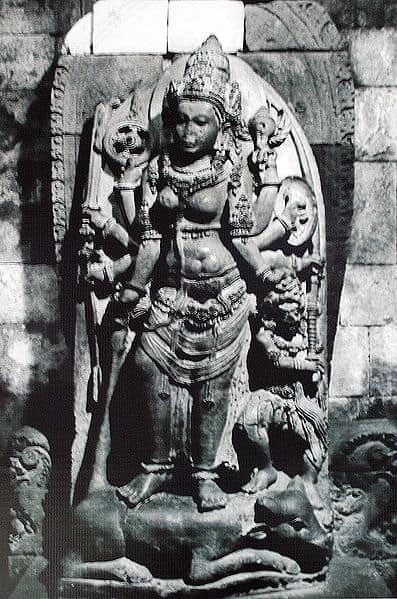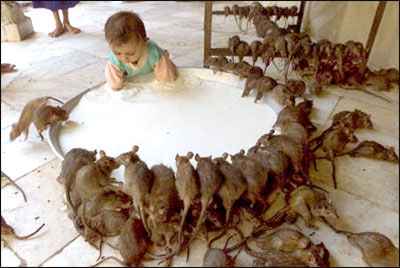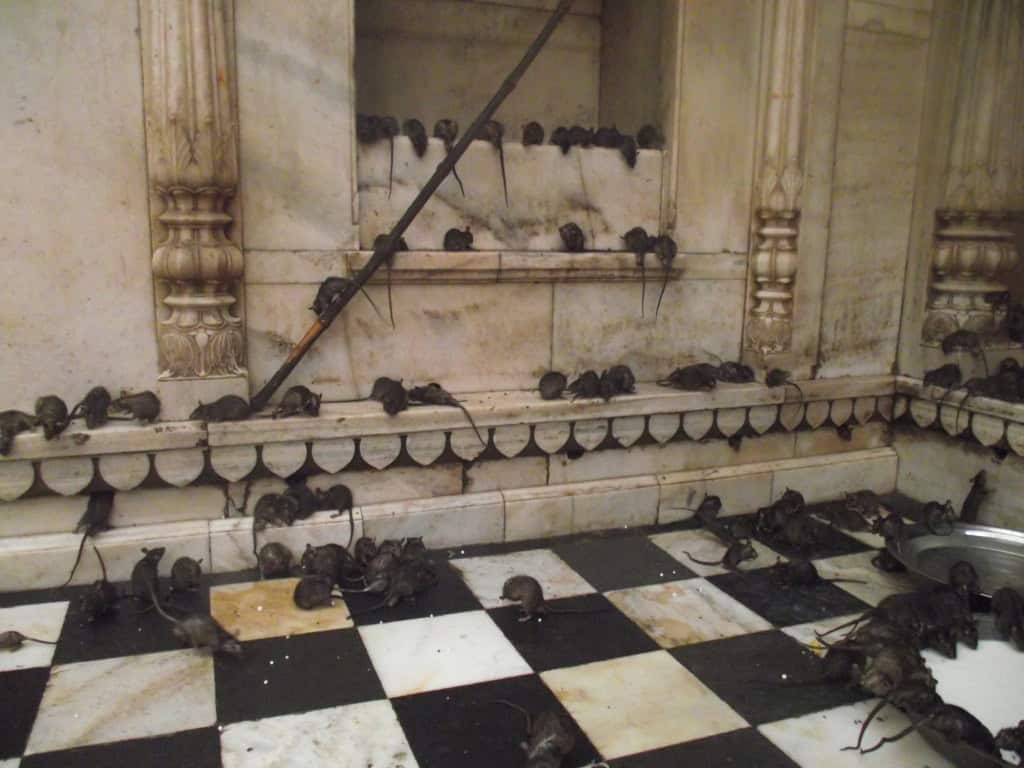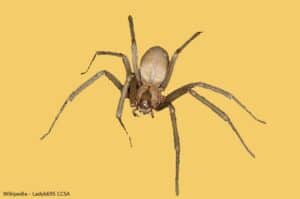The Temple of Rats – Karni Mata
Throughout India animals can be seen living on the streets among people. They are portrayed in decorative art, on temples and in homes. Spiritually, for many Hindus, there is no difference between the sentience between humans and other forms of life. All animals are seen as manifestations of god and possess a soul. Buddha taught that the all beings, in animal form, were our family members and friends in past lives. According to Hindu and Buddhist beliefs, all human beings and animal life are interconnected.

This mix of animal and human societies can be seen at the Indian temple of Karni Mata Temple. The temple was rebuilt in the early 1900’s by Maharaja Ganga Singh to honor the goddess Karni Mata. This ornate temple is constructed of marble and decorated in silver and gold. Visitors from all over India leave their shoes at the door as they enter to pay homage to the 20,000 rats that make the temple their home.
There is a legend about a 14th century mystic matriarch, Karni Mata, who was considered the incarnation of Durga, the goddess of power and victory. As the legend has it, her stepson, Laxman (some sources say it was the son of her storyteller), drowned in a pond when drinking from it. Karni Mata pleaded with Yama, the god of death, to bring her stepson back to life. At first Yama refused but relented when Karni Mata agreed to a deal. Karni Mata’s deal permitted Yama to reincarnate Laxman and all male children (or clansmen, depending on the source) as rats until they could be reincarnated back into human beings.
The Temple of Rats of Karni Mata was rebuilt by in the late Mughal style by Maharaja Ganga Singh of Bikanaer. Singh is best remembered as the ruling Maharaja of Bikaner from 1888 to 1948. He was a modern reformist and the only non-white member of the British imperial War Cabinet during World War I. The front of the temple has a beautiful marble façade, with solid silver doors. There is a walkway lined with detailed panels depicting legends of the goddess. Her image is enshrined in the inner sanctum of the temple.
The few white rats found at Karni Mata are considered especially holy. These white rats are considered to be the actual reincarnates of Karni Mata’s sons. Sighting them or touching them is brings a lifelong blessing to the fortunate worshipper.

What makes the temple unique, are the hundreds of rats living happily and unharmed within its confines. The rats themselves are not worshiped; it is the souls of Karni Mata’s sons and her followers. Worshipers to the temple leave theirs shoes at the marble arched doorway and enter the inner sanctum where rats, also known as kabas, are free to roam. Worshipers bring offerings for the rats to eat inside the shrine. Many consider it auspicious to eat leftovers nibbled by the kabas. Worshipers and pilgrims will walk barefooted throughout the temple (and among the droppings) allowing rats to scamper across their bare feet, spending hours looking for the sacred white rats.
The rats are graze on offerings throughout the day. Around midday they huddle around a large bowl of buffalo milk set before them outside the temple’s inner sanctum. This daily offering can cost up to $4032 a year. These rats have lost their fear of man and, unlike feral rats, are out in full daylight. Feral rats do not enter the compound and the temple rats never seem to leave. These well cared for temple rats are reportedly healthier than feral rats. Indeed, there are no reports of rat carried infections among worshipers and pilgrims at the temple.

In the temple’s early history, Hindu tradition mandated that anyone who inadvertently killed a rat by stepping on it hand to pay the rat’s weight in gold to the temple. However, this practice was as impractical in ancient times as it is today. Today, the temple sells small sterling silver rats cover such accidents.
In a land where the average yearly wage is $642 and 450 million live in poverty, many are outraged at the practice of caring for and worshiping the Karni Mata Rats. But, with over 600 families claiming to be descendants of Karni Marta, there are plenty of faithful who continue to flock to the temple to worship the rats with offerings of sweetmeats and coconuts. These are presented to the priest in exchange for blessings and the application of kumkuma, the orange powder used to mark the Bindi (dot) on a followers forehead. This dot represents the third (or inner) eye in Hindu tradition.
Visitors to Bikanar can best enjoy the Temple of Rats during the semi-annual Karni Mata festival. Twice a year, in March-April, and again in September-October, the community opens the rat temple to the public. The fair is a major tourist s attraction for the Bikaner.
Bibliography for Rats in Religion
The Temple of Rats – Karni Mata -Bibliography


